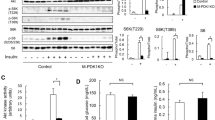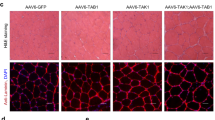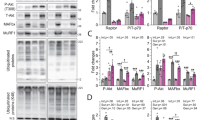Abstract
Skeletal muscle hypertrophy and regeneration are important adaptive responses to both physical activity and pathological stimuli1. Failure to maintain these processes underlies the loss of skeletal muscle mass and strength that occurs with ageing and in myopathies2. Here we show that stable expression of a gene encoding insulin-like growth factor 1 (IGF-1) in C2C12 skeletal muscle cells, or treatment of these cells with recombinant IGF-1 or with insulin and dexamethasone, results in hypertrophy of differentiated myotubes and a switch to glycolytic metabolism. Treatment with IGF-1 or insulin and dexamethasone mobilizes intracellular calcium, activates the Ca2+/calmodulin-dependent phosphatase calcineurin, and induces the nuclear translocation of the transcription factor NF-ATc1. Hypertrophy is suppressed by the calcineurin inhibitors cyclosporin A or FK506, but not by inhibitors of the MAP-kinase or phosphatidylinositol-3-OH kinase pathways. Injecting rat latissimus dorsi muscle with a plasmid encoding IGF-1 also activates calcineurin, mobilizes satellite cells and causes a switch to glycolytic metabolism. We propose that growth-factor-induced skeletal-muscle hypertrophy and changes in myofibre phenotype are mediated by calcium mobilization and are critically regulated by the calcineurin/NF-ATc1 signalling pathway.
This is a preview of subscription content, access via your institution
Access options
Subscribe to this journal
Receive 51 print issues and online access
$199.00 per year
only $3.90 per issue
Buy this article
- Purchase on Springer Link
- Instant access to full article PDF
Prices may be subject to local taxes which are calculated during checkout




Similar content being viewed by others
References
Pette, D. & Staron, R. S. Mammalian skeletal muscle fiber type transitions. Int. Rev. Cytology 170, 143–223 (1997).
Barton-Davis, E. R. et al. Viral mediated expression of insulin-like growth factor 1 blocks the aging-related loss of skeletal muscle function. Porc. Natl Acad. Sci. USA 95, 15603–15607 (1998).
Florini, J. R., Ewton, D. Z. & Coolican, S. A. Growth hormone and the insulin-like growth factor system in myogenesis. Endocrine Rev. 17, 481–517 (1996).
Semsarian, C., Sutrave, P., Richmond, D. R. & Graham, R. M. IGF-induced myotube hypertrophy associated with an increase in anaerobic glycolysis in a clonal skeletal muscle cell model. Biochem. J. 339, 443–451 (1999).
Tesch, P. A., Thorsson, A. & Kaiser, P. Muscle capillary supply and fiber type characteristics in weight and power lifters. J. Appl. Physiol: Respirat. Environ. Exercise Physiol. 56, 35–38 (1984).
Sutrave, P., Kelly, A. M. & Hughes, S. H. ski can cause selective growth of skeletal muscle in transgenic mice. Genes Dev. 4, 1462–1472 (1990).
Molkentin, J. D. et al. Acalcineurin-dependent transcriptional pathway for cardiac hypertrophy. Cell 93, 215–228 (1998).
Luo, Z., Shyu, K.-G., Gualberto, A. & Walsh, K. Calcineurin inhibitors and cardiac hypertrophy. Nature Med. 4, 1092–1093 (1998).
Zhang, W. et al. Failure of calcineurin inhibitors to prevent pressure-overload left ventricular hypertrophy in rats. Cir. Res. 84, 722–728 (1999).
Renganathan, M., Messi, M. L. & Delbono, O. Overexpression of IGF-1 exclusively in skeletal muscle prevents age-related decline in the number of dihydrophyridine receptors. J. Biol. Chem. 273, 28845–28851 (1998).
Wang, Z. M., Messi, M. L., Renganathan, M. & Delbono, O. Insulin-like growth factor-1 enhances rat skeletal muscle charge movement and L-type Ca2+_ channel gene expression. J. Physiol. 516, 331–341 (1999).
Kazaki, M., Nie, L., Shibata, H. & Kojima, I. Activation of a calcium-permeable cation channel CD20 expressed in Balb/C 3T3 cells by insulin-like growth factor-I. J. Biol. Chem. 272, 4964–4969 (1997).
Coolican, S. A. et al. The mitogenic and myogenic actions of insulin-like growth factors utilize distinct signaling pathways. J. Biol. Chem. 272, 6653–6662 (1997).
Musaro, A. & Rosenthal, N. Maturation of the myogenic program is induced by post-mitotic expression of IGF-1. Mol. Cell. Biol. 19, 3115–3124 (1999).
Montano, M. M. & Lim, R. W. Glucocorticoid effects on the skeletal muscle differentiation program: analysis of clonal proliferation, morphological differentiation and the expression of muscle-specific regulatory genes. Endocr. Res. 23, 37–57 (1997).
Giorgino, F. & Smith, R. J. Dexamethosone enhances insulin-like growth factor-1 effects on skeletal muscle cell proliferation. J. Clin. Invest. 96, 1473–1483 (1995).
Bruton, J. D., Katz, A. & Westerblad, H. Insulin increase near-membrane but not global Ca2+ in isolated skeletal muscle. Proc. Natl Acad. Sci. USA 96, 3281–3286 (1999).
Chin, E. R. et al. Acalcineurin-dependent transcriptional pathway controls skeletal muscle fiber type. Genes Dev. 12, 2499–2509 (1998).
Abbott, K. L. et al. Activation and cellular localization of the cyclosporine A-sensitive transcription factor NF-AT in skeletal muscle cells. Mol. Biol. Cell 9, 2905–2916 (1998).
Beals, C. R. et al. Nuclear export of NF-ATc enhanced by glocogen synthase kinase-3. Science 275, 1930–1933 (1997).
Rosenblatt, J. D. & Parry, D. J. Gamma irradiation prevents compensatory hypertrophy of overloaded mouse extensor digitorum longus muscle. J. Appl. Physiol. 73, 2538–2543 (1992).
Musarò, A., McCullagh, K. J. A., Naya, F. J., Olson, E. N. & Rosenthal, N. IGF-1 induces skeletal myocyte hypertrophy through calcineurin in association with GATA-2 and NF-ATc1 Nature 400, 581–585 (1999).
Dolmetsch, R. E., Lewis, R. S., Goodnow, C. C. & Healy, J. I. Differential activation of transcription factors induced by Ca2+ response amplitude and duration. Nature 386, 855–858 (1997).
Zhu, J. & McKeon, F. NF-AT activation requires suppression of Crm1-dependent export by calcineurin. Nature 398, 256–260 (1999).
Hogan, P. G. & Rao, A. Modification by nuclear export? Nature 398, 200–201 (1999).
Crabtree, G. R. Generic signals and specific outcomes: signaling through Ca2+ calcineurin, and NF-AT. Cell 96, 611–614 (1999).
De Koninck, P. & Schulman, H. Sensitivity of CaM kinase II to the frequency of Ca2+ oscillations. Science 279, 227–230 (1998).
Fruman, D. A. et al. Measurement of calcineurin phosphatase activity in cell extracts. Methods 9, 146–154 (1996).
Lyakh, L., Ghosh, P. & Rice, N. R. Expression of NFAT-family proteins in normal human T cells. Mol. Cell. Biol. 17, 2465–2484 (1997).
Ju, Y.-K. & Allen, D. G. Intracellular calcium and Na-Ca2+ exchange current in isolated toad pacemaker cells. J. Physiol. 508, 153–166 (1998).
Acknowledgements
Supported in part by funds donated in memory of Diana, Princess of Wales. We thank P. Poronnik and C. Lee for IGF-1 expression vector reagents; N. Rosenthal for sharing unpublished data; P. Gunning for C2C12 cells; M. Fujioka (Fujisawa) for supplying FK506; C. Klee for the ‘Free Calcium’ program; K. Walsh, E. Hardeman, A. Gualberto and P. Sutrave for helpful discussions; and E.Martin and N. Groves for preparation for this manuscript. This work was supported by NH and MRC Medical Research Scholarships (to C.S. and T.Y.).
Author information
Authors and Affiliations
Corresponding author
Rights and permissions
About this article
Cite this article
Semsarian, C., Wu, MJ., Ju, YK. et al. Skeletal muscle hypertrophy is mediated by a Ca2+-dependent calcineurin signalling pathway. Nature 400, 576–581 (1999). https://doi.org/10.1038/23054
Received:
Accepted:
Issue Date:
DOI: https://doi.org/10.1038/23054
This article is cited by
-
Association between hospital acquired disability and post-discharge mortality in patients after living donor liver transplantation
BMC Surgery (2022)
-
Clinical impact of sarcopenia assessment in patients with hepatocellular carcinoma undergoing treatments
Journal of Gastroenterology (2020)
-
LIM and cysteine-rich domains 1 (LMCD1) regulates skeletal muscle hypertrophy, calcium handling, and force
Skeletal Muscle (2019)
-
Stabilin-2 modulates the efficiency of myoblast fusion during myogenic differentiation and muscle regeneration
Nature Communications (2016)
-
13-Methylberberine, a berberine analogue with stronger anti-adipogenic effects on mouse 3T3-L1 cells
Scientific Reports (2016)
Comments
By submitting a comment you agree to abide by our Terms and Community Guidelines. If you find something abusive or that does not comply with our terms or guidelines please flag it as inappropriate.



